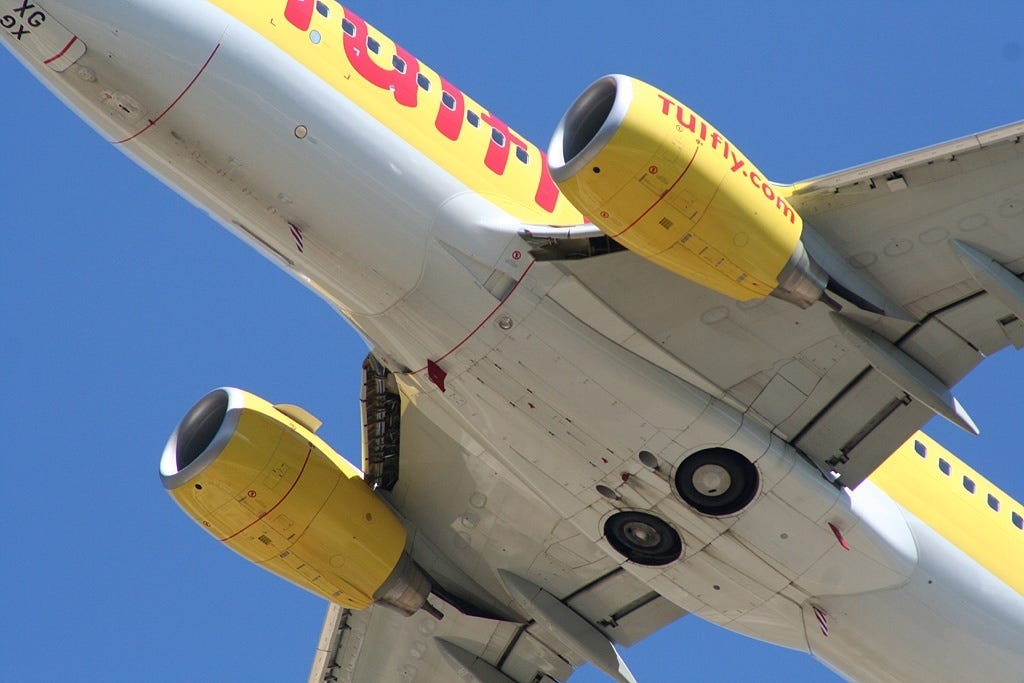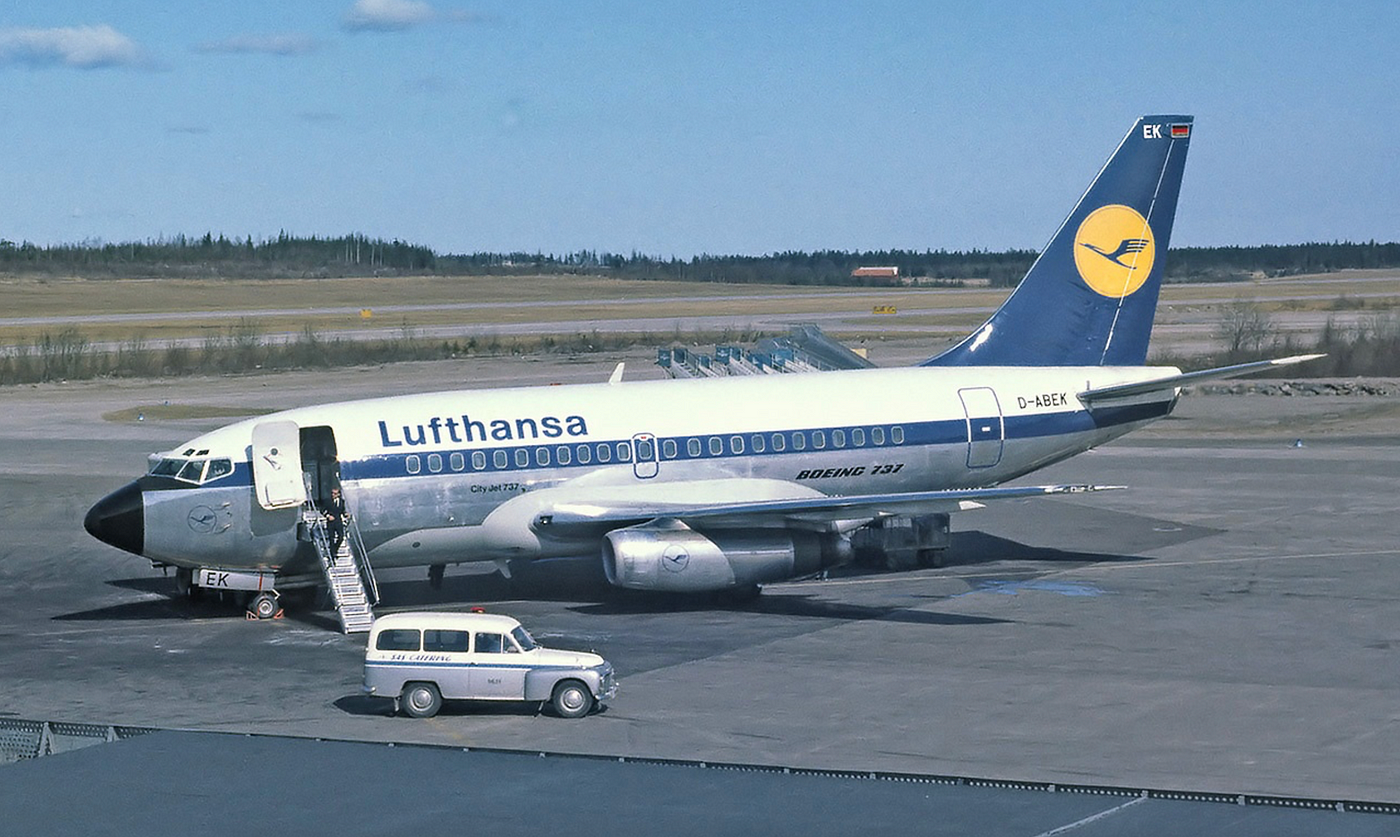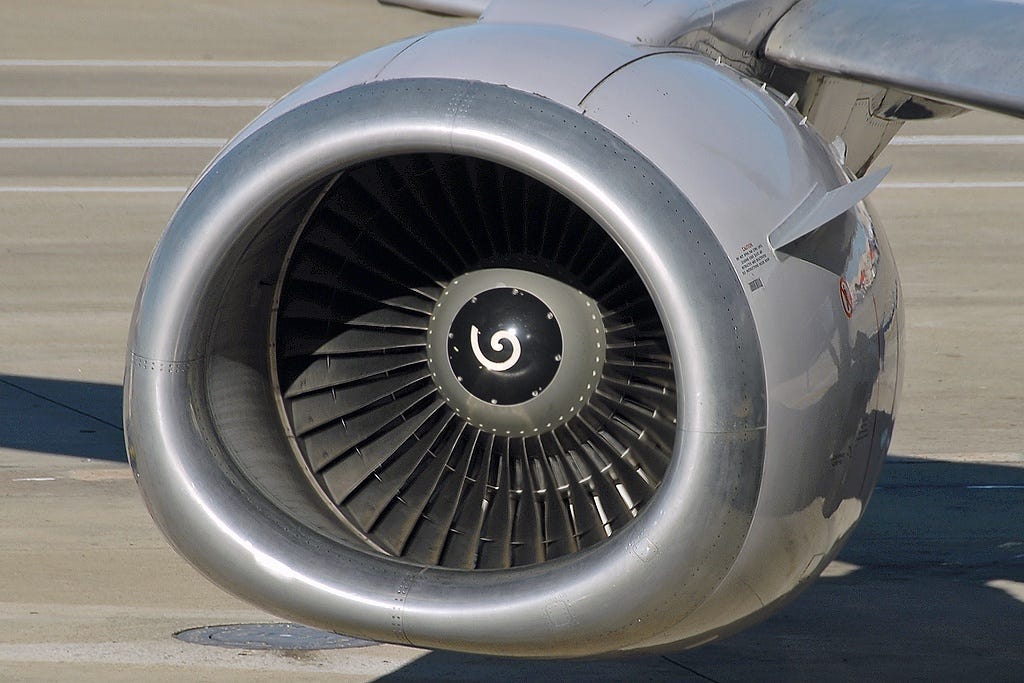Passenger Plane Landing Gear Drawings
Why doesn't the Boeing 737 take landing gear doors?
This is what the underside of a Boeing 737 looks like during flight:

The aircraft's chief landing gear wheels are not covered, and they remain exposed even when fully retracted. The olfactory organ cycle, on the other mitt, is covered.
Given the lack of infinite nether the plane while it's on the ground, Boeing engineers determined that landing gear doors were impractical and unnecessary for the main undercarriage. Let me explain.
These "holes" on the Boeing 737's belly isn't unique to the airplane. For instance, the Embraer Eastward-jet family also has a similar design:

The same goes for the ATR 42/72 turboprops.

These planes all share like characteristics — they're curt-range, domestic/regional airliners with short landing gears and limited space betwixt the fuselage and the ground.
This is the earliest 737 model from the late 1960s:

The modern-mean solar day 737–800 was built on the foundation of the kickoff-generation, retaining much of the original structural design, even as the 737'due south role evolved from a short-range, domestic aircraft to at present a medium-, and fifty-fifty long-range, airliner flying transatlantic missions, for example.


With the exception of the 737 Max, every 737 fitted with high-bypass turbofan engines volition have engine inlets that are slightly ovoid to provide sufficient clearance between the engines and the basis.


The brusk landing gear struts on the 737 necessitate such workarounds. So why make them short?
In the 1960s, Boeing positioned the 737 as an airliner that could serve minor, domestic airports. Unlike major international airports, domestic aerodrome in those days didn't accept sophisticated facilities, such equally airbridges, cargo loaders and belt loaders that could reach high places.

Therefore, Boeing decided to brand the 737 as low to the ground as possible. This allowed baggage handlers to load baggage without requiring much footing support equipment, and to climb into the cargo hold to load, organize and remember the numberless.
The plane could be refuelled and serviced using smaller domestic airport trucks, and footing staff would not need to use lifting platforms to access the valves and servicing panels on the underside of the aircraft.
Passengers will board and disembark the 737 using airstairs, rather than airbridges.
Since the plane was deliberately designed to exist low, there wasn't enough space under the aircraft to conform bike well doors for the main landing gear. If implemented, the doors will likely come up in contact with the track, taxiway or apron surface should they exist deployed on the ground. When the aeroplane is in motion, they could potentially scrape the asphalt or concrete and crusade impairment.
You might be thinking — just the doors volition never be actuated on the ground, simply in the air. It'southward important for Boeing to ensure absolute safety in the blueprint of their airplanes. There had been numerous incidents where the landing gear failed to deploy, resulting in emergency abdomen landings.
The landing gear is susceptible to failure, and then are their doors. If the 737 were to exist equipped with landing gear bay doors, and they fail to close upward earlier landing, things wouldn't be proficient when the airplane touches down.
But at that place's more to it.
Landing gear doors and their mechanisms have up space within the abdomen of the aircraft, add weight to the aircraft, increase design complexity and require boosted maintenance. This led Boeing engineers to ponder if the landing gear doors were actually a necessity.
Given the reduced ground clearance of the 737, which rendered the wheel well doors much less viable than other airplanes, and complications associated with developing and implementing the doors, Boeing decided to omit them in favour of a simpler culling solution.
This solution involves two items — a hubcap and a rubber seal.
The hubcap is a circular metal rim cover that encloses the hub (heart) of the airplane's cycle.

The hubcaps are attached onto the sides of 2 main landing gear wheels that are visible after the gear is retracted, and their main purpose is to smoothen the surface of the wheels, forming a fairly aerodynamic surface and reducing drag.

The rubber seal surrounds the opening of each wheel well, sealing off the gap between the cycle and fuselage surface one time the gear is retracted. This creates a protective barrier that prevents foreign objects, rain, and other elements from entering and potentially dissentious the components inside.

This seal consists of many thick, curved pieces of prophylactic overlapping each other. When the cycle is fully retracted, it will push the drooping safe pieces up, securing them in place.

So, to recap, the exposed sides of the main landing gear wheels are capped with hubcaps, making them more aerodynamic. The condom seals fitted along the border of the cycle well safeguard inner components from external conditions.
This is substantially Boeing's workaround for the lack of landing gear bay doors. Yet, it cannot fully recoup for the doors' absenteeism, because the shipping'southward bike well is wide open up when the principal landing gear is extended, as shown in this picture:

This means the wheel wells are vulnerable to harm from foreign droppings during taxiing, takeoff and landing, which is the main drawback of this design.
Nonetheless, the 737 has been effectually for 50+ years, and it has gone through many generations of upgrades and modernisations. Yet, not a single wheel bay door has ever been installed, so this isn't really a pressing upshot faced by 737 operators.
The unprotected wheel wells on the 737 too makes information technology easier for stowaways to climb in, compared to an Airbus A320, for case.

Withal, this is negligible, because there's no data to suggest airliners without landing gear bay doors more usually involved in stowaways flights than those with the doors.
In determination, the reason why the Boeing 737 does non have covers for the landing gear wheels is more often than not because of its original founding pattern.
It was built to be a short-haul, regional airliner, with low footing separation, allowing ground staff working in pocket-sized domestic airports to service and prepare the aircraft easily in lite of the constrains and limitations of those airports in the 1960s.
With such a design, landing gear doors were not deemed feasible by Boeing, from a rubber standpoint. Additionally, the complications surrounding development of the landing gear bay doors, as well as the added weight and maintenance considerations ultimately led Boeing to conceive a workaround that reduced the overall complication of the Boeing 737 project.
Thanks for reading.

Source: https://isaaclow.medium.com/why-doesnt-the-boeing-737-have-landing-gear-doors-3e47b82362c1
0 Response to "Passenger Plane Landing Gear Drawings"
Post a Comment